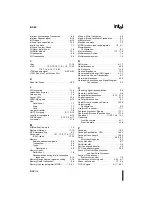
A-19
SIGNALS REFERENCE
A.1.43. RESET# (I)
The RESET# signal is the Execution Control group reset signal. Asserting RESET# resets all
Pentium Pro processors to known states and invalidates their L1 and L2 caches without writing
back Modified (M state) lines. RESET# must remain active for one microsecond for a “warm”
reset. For a power-on type reset, RESET# must stay active for at least one millisecond after Vcc
and CLK have reached their proper DC and AC specifications. On observing active RESET#,
all bus agents must deassert their outputs within two clocks.
A number of bus signals are sampled at the active-to-inactive transition of RESET# for the pow-
er-on configuration. The configuration options are described in Chapter 9, Configuration and in
every signal description in this chapter.
Unless its outputs are tristated during power-on configuration, after active-to-inactive transition
of RESET#, the Pentium Pro processor optionally executes its built-in self-test (BIST) and be-
gins program execution at reset-vector 0_000F_FFF0H or 0_FFFF_FFF0H.
A.1.44. RP# (I/O)
The RP# signal is the Request Parity signal. It is driven by the request initiator in both clocks of
the Request Phase. RP# provides parity protection on ADS# and REQ[4:0]#. When a Pentium
Pro processor bus agent observes an RP# parity error on any one of the two Request Phase
clocks, it must assert AERR# in the Error Phase, provided “AERR# drive” is enabled during the
power-on configuration.
I/O Write
1
0
0
0
1
DSZ#
x
LEN#
Rsvd
(Ignore)
1
1
0
0
x
DSZ#
x
x
x
Memory Read &
Invalidate
ASZ#
0
1
0
DSZ#
x
LEN#
Rsvd
(Memory Write)
ASZ#
0
1
1
DSZ#
x
LEN#
Memory Code Read
ASZ#
1
D/C#=
0
0
DSZ#
x
LEN#
Memory Data Read
ASZ#
1
D/C#=
1
0
DSZ#
x
LEN#
Memory Write (may not
be retried)
ASZ#
1
W/WB
#=0
1
DSZ#
x
LEN#
Memory Write (may be
retried)
ASZ#
1
W/WB
#=1
1
DSZ#
x
LEN#
Table A-9. Transaction Types Defined by REQa#/REQb# Signals
Transaction
REQa[4:0]# REQb[4:0]#
4
3
2
1
0
4
3
2
1
0
Summary of Contents for Pentium Pro Family
Page 17: ...1 Component Introduction ...
Page 26: ...2 Pentium Pro Processor Architecture Overview ...
Page 27: ......
Page 36: ...3 Bus Overview ...
Page 62: ...4 Bus Protocol ...
Page 105: ...5 Bus Transactions and Operations ...
Page 126: ...6 Range Registers ...
Page 131: ...7 Cache Protocol ...
Page 135: ...8 Data Integrity ...
Page 148: ...9 Configuration ...
Page 161: ...10 Pentium Pro Processor Test Access Port TAP ...
Page 172: ...11 Electrical Specifications ...
Page 201: ...12 GTL Interface Specification ...
Page 229: ...13 3 3V Tolerant Signal Quality Specifications ...
Page 233: ...14 Thermal Specifications ...
Page 239: ...15 Mechanical Specifications ...
Page 241: ...15 2 MECHANICAL SPECIFICATIONS s Figure 15 1 Package Dimensions Bottom View ...
Page 252: ...16 Tools ...
Page 260: ...16 8 TOOLS Figure 16 4 Generic MP System Layout for Debug Port Connection ...
Page 264: ...17 OverDrive Processor Socket Specification ...
Page 290: ...A Signals Reference ...
Page 320: ...Index ...
Page 328: ......
















































